
Plot Structure: A Guide to Crafting Compelling Movie Narratives
Dive into the intricacies of plot structure to master the art of weaving compelling movie narratives that captivate readers from beginning to end.
This guide to plot structure will give you all the tools to craft compelling movie narratives.
We have all fantasised about our box office triumph; maybe it is time to make it a reality.
One of the first steps to successful filmmaking is a captivating well-structured plot.
Let’s dive in and learn how to weave dynamic, rocking movie plots that will engage audiences from beginning to end.
Table of Contents
What Is Plot Structure and Why Does It Matter in Movie Making?
The plot of a story is everything when it comes to dynamic filmmaking. In simple terms, a plot is the sequence of events that define the story.
Even off-the-wall visual effects will struggle to make a script compelling without a structure.
The movie might have a fantastic storyline. However, if there is no plot structure, there will be no clear boundary for people to decipher the message.
Plots employ cause and effect and weave together a complete comprehensive picture.
Writing a script with no plot is similar to randomly throwing ingredients into a pot with no recipe. Then expect the pot to produce a delicious spinach pie for your dinner guests. It just ain’t gonna happen!
It is the same with a movie. Without a structure and plot of the story, the result will be a confusing sequence of events. This makes it difficult for the audience to digest.
Plot points lead the audience through the story. Pacing them with deliberate intention through pivotal moments of realisation, climax and outcome.
The bottom line is that to create a captivating movie, it will need a structured plot.
What Makes a Movie Plot Good?

Credit: Kyle Head
There are different factors when combined at the right time, will make a good movie plot.
The main elements of a plot are setup, conflict and resolution. To construct a good movie, you need to know how to hold the audience’s attention.
To do this, the story needs to be escalated and resolved at the right pace.
For example, if a movie escalates too fast, the audience will not have time to experience the suspense. Therefore, they will not be emotionally invested.
A movie plot that keeps people in suspense will keep them engaged.
If the resolution stage is too slow, the audience could get bored and lose interest.
At its most basic, a good movie plot will keep the audience entertained. If an audience is fidgeting and looking for the door, the movie plot has failed.
Another indication of a good plot is one which provokes people to think about a concept.
Clarence Quinteino is a master of good movie plots. He successfully weaves together complex and unconventional story plots in his movies.
The 4 Types of Plot Story Structure
There are four distinct types of plot linear, episodic, parallel and flashback.
Linear Plot
The linear plot of a story is set out in chronological order, with a clear beginning, middle and end.
The characters of the storyline move through time in a linear fashion as we do day to day.
The linear plot is the most commonly used type of plot.
In five seconds, you can probably name three movies off the top of your head which use a linear story plot.
Episodic Plot
Episodic plots have multiple storylines. These storylines are linked by a character, theme or place.
However, although they are linked, they are also held apart by time, theme or purpose.
An example is the all-time classic, One Hundred Years of Solitude, by Gabriel Garcia Marquez.
In this novel, each chapter narrates the story of characters from the Buendia family.
They are linked by town and bloodline but separated by time.

Credit: Denise Jans
Parallel Plot
The parallel plot of a story is similar to the episodic plot. The characters are also linked by character, theme or place.
However, they are not held apart. An intrinsic part of a parallel plot is that the characters connect at key points during the movie.
The plot climaxes when the separate storylines merge at the end of the movie.
An example of a parallel story plot is the popular animation Finding Nemo.
Nemo, the main character, attempts to escape his fish bowl while Dora searches for her lost family.
Flashback Plot
The flashback plot jumps from one timeline to another when the past and present can be compared.
If not executed well, it can be disorientating for the viewer. When done correctly, it can be a gripping narrative style.
The flashback plot can be used to expose insights or forgotten family secrets.
An example is Eternal Sunshine of My Spotless Mind. The main character, Joel, is going through a memory-removing procedure.
How Do You Structure a Plot?
To structure a plot, use the following five stages as the basis for the storyline.

Credit: Cotton Bro Studio
The 5 Stages of Structuring a Story Plot
There are five main stages of plot story structure. These are exposition, rising action, climax, falling action, and resolution.
Exposition
The exposition sets the mood and background of the movie.
It is the time when the main characters are introduced. This is the scene that provides the foundation for the movie.
Rising Action
The rising action is the inciting incident that happens before the story’s climax.
It is the pieces of the story plot that will culminate in a pinnacle climaxing scene.
Rising action builds the necessary tension to keep the audience emotionally involved.
The audience is now invested and wants to see how the story will be resolved.
Climaxing
The climax is when the movie reaches its high point, its pinnacle.
This is the scene when the movie reaches the apex of the main conflict.
All the components of the storyline are brought together to a climax.
Falling Action
The falling action stage of a story plot is the movie’s turning point when the tension is wound down.
The story switches from building tension. Now it starts to prepare the audience for a resolution.

Credit: Jon Tyson
Resolution
Finally, everyone needs a conclusion, or a resolution. The resolution is the final stage to wind up and conclude the story.
This is the plot point when loose ends of the story are tied up, and the audience will realise the message of the movie.
Without a conclusion, the movie appears to end abruptly. If this happens, the audience will leave the movie theatre confused.
How to Use a Plot Diagram
A plot diagram is one of the essential building blocks for constructing a cohesive story.
A plot diagram creates a visual so the writer can view the main points of the storyline.
Along the plot diagram, points and notes can be added. Notes related to character development, the inciting incident and the story arc.
Different shaped graphics are used to represent different plot story structures.
For a three-act plot, a triangle or mountain is used. The left side of the mountain is the first stage, the exposition.
The top of the mountain is the middle stage, the climax. The right side of the mountain is the last stage, falling action to resolution.
A plot diagram for a parallel line plot with three parallel stories will use three lines.
The three lines will represent the three parallel storylines.
Each time the lines cross will represent the scenes where the storylines cross over.
The writer can add relevant notes to the plot diagram relating to the story structure.
The visual representation of the plot gives a writer perspective on the flow of the entire story.
It clearly demonstrates scenes where there is a congestion or lack of information.
This plot diagram also allows a writer to view how the plot elements work together.
Plot Elements Every Story Needs

Credit: Aaron Burden
Almost every story’s plot ever told, written or acted has the same integral elements. It is these elements which keep audiences transfixed.
To hold the audience’s attention, the plot needs to deliver elements at optimum times.
Neither too fast nor too slow.
The main elements can be summed up as beginning, middle and end. But to grasp the concept of story writing on a deeper level, let’s break it down more concisely.
The story’s opening scene is the exposition element. This is the story’s backdrop. The main characters are introduced, and the time and location are given.
The opening scene is important to establish the theme of the movie.
After the opening (exposition element) comes the rising action element.
The rising action element is an inciting incident that will kick off the plot action.
This element is needed to create tension and is often a problem that needs to be solved.
The problem creates intrigue and emotionally hooks the audience to keep them engaged.
At this point in the movie, the audience wants to know how the issue will be resolved.

Credit: Felix Mooneeram
Following the rising action comes the climax. The Climax is when the problem is escalated to its endpoint, and the story reaches its pinnacle.
The next two elements are falling action and resolution.
It is possible to jump straight from the climax to the resolution, although it is not advisable.
Only try this when the climax has not been too exhilarating for the audience.
After the climax, the audience will need time to process the action.
Falling action will help lead the audience out of the storyline at a gentle pace. Giving them time to mentally adjust.
The resolution is needed to wind up the story. This is the time when the storyteller can deliver their message and tie up the loose ends of the story.
Without a resolution, the audience is left wondering what the purpose of the story was.
10 Examples of Plot Structures
The following are some plot examples to consider when writing your own story.
Overcoming the Monster
In overcoming the monster, the plot line is defined by a conflict between the protagonist and a monster.
The story arc follows the protagonists as they struggle to defeat the invincible enemy.
The monster doesn’t have to be an actual being but can be an inner conflict.
Day of the Triffids and Jaws are two examples of overcoming the monster.

Credit: GR Stocks
Hero’s Journey, Story or Quest
The Hero’s journey follows the quest of a main character. The hero normally starts the adventure as an ordinary person in an ordinary world.
The hero must rise to extraordinary challenges drawing on skills they didn’t know they possessed.
Once they have succeded, they emerge as a changed person, a hero.
The Hobbit and Harry Potter are two examples of the Hero’s story.
Voyage and Return
In the Voyage and Return storyline, the protagonist departs on a voyage.
The Voyage and Return is similar to the Quest plotline. Both involve voyages and adversities.
The main difference is that during the Quest, a task must be accomplished.
Whereas the Voyage and Return only requires that the protagonist returns home.
The Wizard of Oz and Gone with the Wind are movies that have voyage and return plot lines.

Credit: Alex Gruber
Rags to Riches
The plot outline follows the main character going from rags to riches.
During the course of the story, the protagonist makes his fortune against all odds.
The Pursuit of Happiness is the perfect example of a Rags to Riches plot type.
Comedy
A Comedy entwines ridiculous and funny aspects and often involves mistakes and secrets.
The plot follows the hero as they triumph over adversity.
A comedy can incorporate additional plot lines, such as the Quest, Romance and Rags to Riches.
Comedies include This is Spinal Tap, Withnail and I and Monty Python’s Life of Brian.
Tragedy
The Tragedy plot line follows the main characters through a time of great difficulty.
The main character will suffer due to events outside of their control. Adversities are compounded due to their incapabilities, flaws or circumstances.
The climax plot point will be one of distress, and the ending is typically an unhappy one.
A Tragedy plot line can be disturbing to watch, but it usually leaves an audience feeling happier.
Voyeurism into the world of adversity makes us realise how fortunate we are.
Rebirth
The story of Rebirth follows the protagonist and their character development.
The story focuses on the main characters as they evolve from a perceived lower state of being.
Their transformation to become a better person is the climaxing point of the story. Examples are Beauty and the Beast and The Grinch.
Romance
Romance is one well-loved storyline from ancient Greek myths to modern-day romance comedies.
A Romance plot usually follows the sequence of rise to fall, then rise again.
Romance stories culminate with the girl winning the heart of the boy, or vice versa.
A Romance always ends with a Cinderella-style happy ending. We must be suckers for deceptive narratives.

Credit: Alex Litvin
Plotless
Okay, and sorry, just to throw a spanner in the works, but there are some stories that just don’t need plot points.
Without a plot, a movie lacks integral building blocks, but some movies manage to make it work.
Examples are Napoleon Dynamite, Breakfast Club and Lost in Translation, to name just a few.
Rules are always there to be broken. So why not shake plot structures up and try something different?
Freytag’s Pyramid
Exposition sets the stage by introducing characters, the setting, and the primary conflict.
Rising Action follows, detailing events that escalate tension as they lead to the story’s climax.
The Climax is the pivotal moment where the main conflict reaches its utmost intensity.
Falling Action ensues, portraying events post-climax, culminating in the Resolution, where conflicts resolve and loose ends are neatly tied up.
FAQs On the Structure of Plots
Are the elements of plot structures the same for a screenplay as for a novel?
The two will be related but definitely not the same.
A key difference is that a screenplay has turning plot points at predictable times.
What is the 3-act structure?
The three-act structure is a timeless plot that can be tracked back to Aristotle’s era.
It comprises three separate acts or sections. The plot has a distinct beginning, middle, and end.
Act 1 sets the tone of the play. Act 2 increases the tension. Act 3 brings the plot resolution.
What is the best story structure for a movie?
The 3-act structure is the best plot for movies as it provides the crucial building blocks for a good story.
A longer or more involved story plot might fail to keep the audience’s attention.
What is it called when you break down a film scene by scene to analyze plot structures?
Breaking down the plot line scene by scene is called “Scene Analysis” or “Scene Breakdown”.
It is one of the best ways to deeply study plot points.
What is an example of exposition in plot structures?
An example of exposition is when the opening scene is set.
This is the time when characters are introduced and the place and time is indicated.
What are nonlinear plot structures?
A non-linear plot is one which is not restricted to a linear timeline.
Instead, it can jump from one timeline to another.
It is a narrative technique that does not stick to a chronological order.
What is the correct order of plot structure?
Generally, a plot will follow a set sequence of events.
These are exposition, rising action, climax, falling action and the resolution.
What is a parallel plot structure?
A parallel plot includes two or more plots in a story.
These parallel plot lines are linked together by a common theme or character.
How do you identify plot structures?
To identify the plot from the theme, look for the plot’s main elements.
The plot elements are exposition, rising action, climax, falling action and the resolution.
The basic structure of a movie follows the 3-act structure open, climax to resolution.

Check out these 8 essential tools to help you succeed as a professional photographer.
Includes limited-time discounts.













